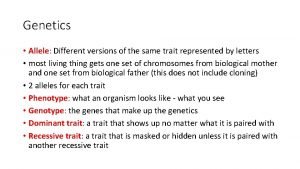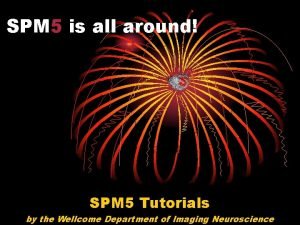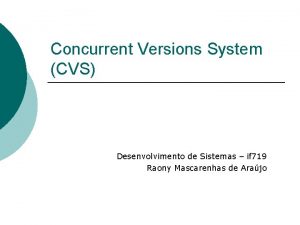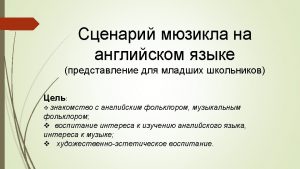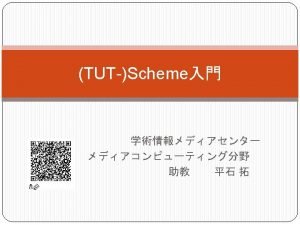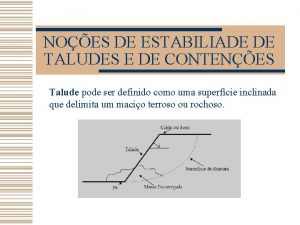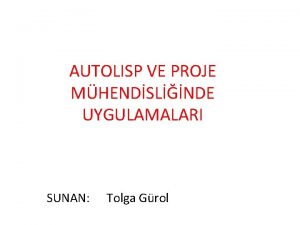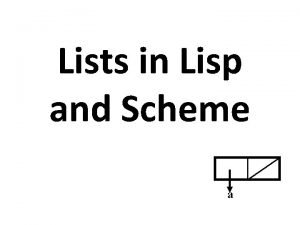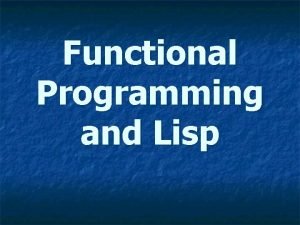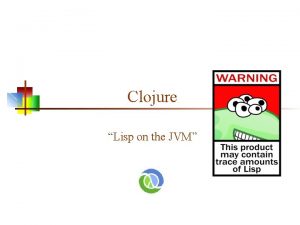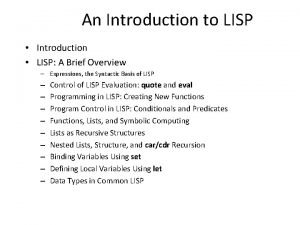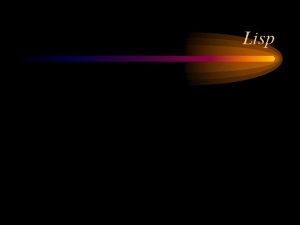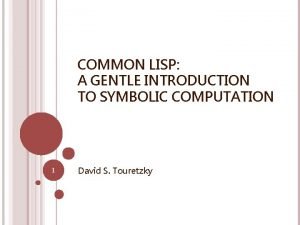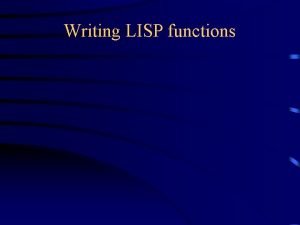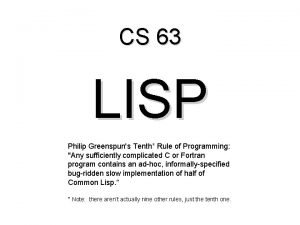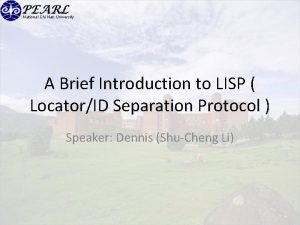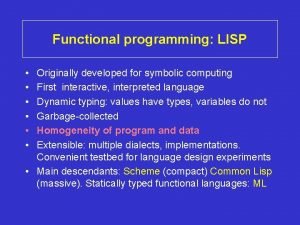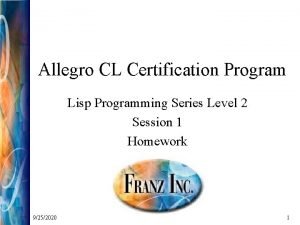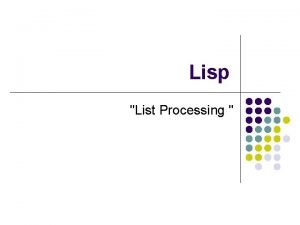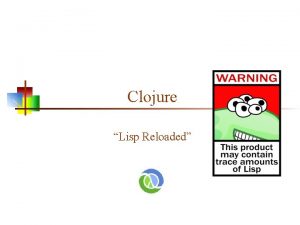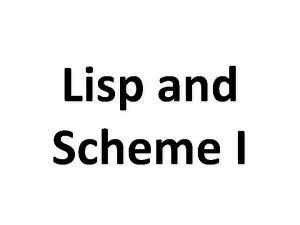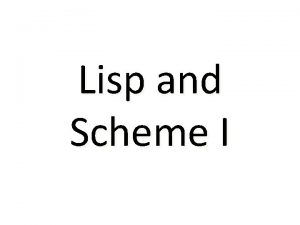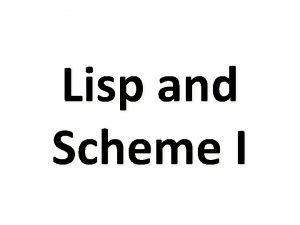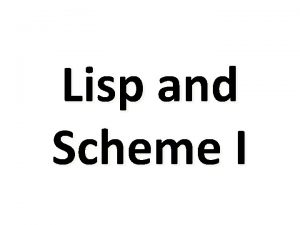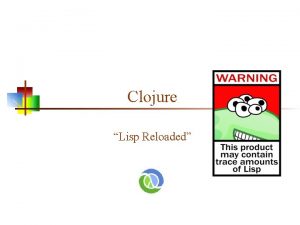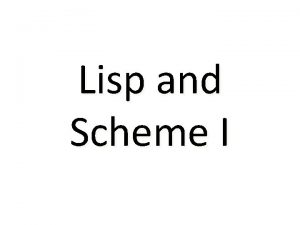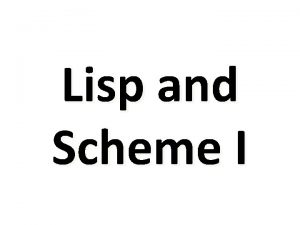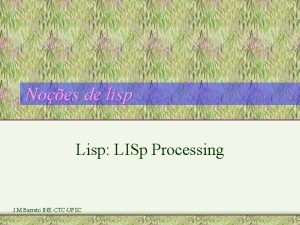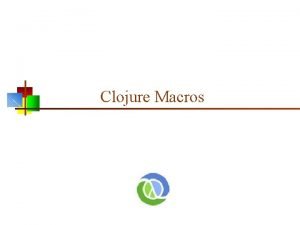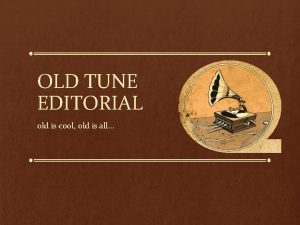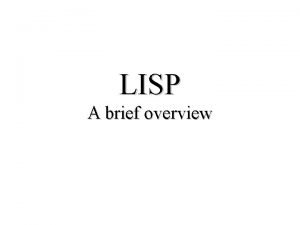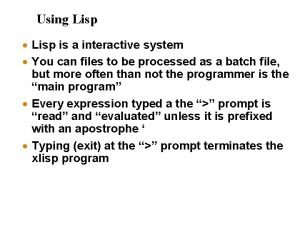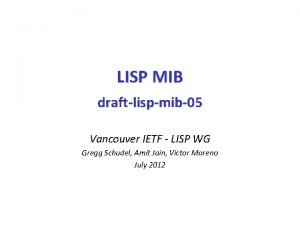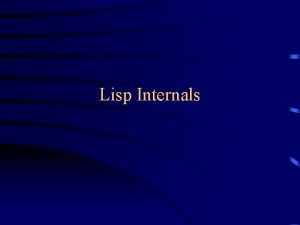Lisp Versions of LISP Lisp is an old




























- Slides: 28

Lisp

Versions of LISP • Lisp is an old language with many variants • Lisp is alive and well today • Most modern versions are based on Common Lisp • Lisp. Works is based on Common Lisp • Scheme is one of the major variants • The essentials haven’t changed much

Recursion • Recursion is essential in Lisp • A recursive definition is a definition in which – certain things are specified as belonging to the category being defined, and – a rule or rules are given for building new things in the category from other things already known to be in the category.

Informal Syntax • An atom is either an integer or an identifier. • A list is a left parenthesis, followed by zero or more S-expressions, followed by a right parenthesis. • An S-expression is an atom or a list. • Example: (A (B 3) (C) ( ( ) ) )

Formal Syntax (approximate) • • <S-expression> : : = <atom> | <list> <atom> : : = <number> | <identifier> <list> : : = ( <S-expressions> ) <S-expressions > : : = <empty> | <S-expressions > <S-expression> • <number> : : = <digit> | <number> <digit> • <identifier> : : = string of printable characters, not including parentheses

T and NIL • • • NIL is the name of the empty list As a test, NIL means “false” T is usually used to mean “true, ” but… …anything that isn’t NIL is “true” NIL is both an atom and a list – it’s defined this way, so just accept it

Function calls and data • A function call is written as a list – the first element is the name of the function – remaining elements are the arguments • Example: (F A B) – calls function F with arguments A and B • Data is written as atoms or lists • Example: (F A B) is a list of three elements – Do you see a problem here?

Quoting • Is (F A B) a call to F, or is it just data? • All literal data must be quoted (atoms, too) • (QUOTE (F A B)) is the list (F A B) – QUOTE is a “special form” – The arguments to a special form are not evaluated • '(F A B) is another way to quote data – There is just one single quote at the beginning – It quotes one S-expression

Basic Functions • • • CAR returns the head of a list CDR returns the tail of a list CONS inserts a new head into a list EQ compares two atoms for equality ATOM tests if its argument is an atom

Other useful Functions • (NULL S) tests if S is the empty list • (LISTP S) tests if S is a list • LIST makes a list of its (evaluated) arguments – (LIST 'A '(B C) 'D) returns (A (B C) D) – (LIST (CDR '(A B)) 'C) returns ((B) C) • APPEND concatenates two lists – (APPEND '(A B) '((X) Y) ) returns (A B (X) Y)

CAR • The CAR of a list is the first thing in the list • CAR is only defined for nonempty lists If L is (A B C) ( (X Y) Z) (()()) () Then (CAR L) is A (X Y) () undefined

CDR • The CDR of a list is what's left when you remove the CAR • CDR is only defined for nonempty lists • The CDR of a list is always a list

CDR examples If L is Then (CDR L) is (A B C) ( (X Y) Z) (B C) (Z) (X) () (()()) () (()) undefined

CONS • CONS takes two arguments – The first argument can be any S-expression – The second argument should be a list • The result is a new list whose CAR is the first argument and whose CDR is the second • Just move one parenthesis to get the result: CONS of A (B C) gives (A B C)

CONS examples • CONS puts together what CAR and CDR take apart L (CAR L) (CDR L) (CONS (CAR L) (CDR L)) (A B C) A (B C) (A B C) ( (X Y) Z) (X Y) (Z) ( (X Y) Z) (X) X () (X) (()()) () undefined

Dotted Pairs • The second argument to CONS should be a list • If it isn't, you get a dotted pair • CONS of A and B is (A. B) • We aren't using dotted pairs in this class • If you get a dotted pair, it's because you gave CONS an atom as a second argument

EQ • EQ tests whether two atoms are equal – Integers are a kind of atom • EQ is undefined for lists – it might work for lists, it might not – but it won't give you an error message • As with any predicate, EQ returns either NIL or something that isn't NIL

ATOM • ATOM takes any S-expression as an argument • ATOM returns "true" if the argument you gave it is an atom • As with any predicate, ATOM returns either NIL or something that isn't NIL

COND • COND implements the if. . . then. . . elseif. . . then. . . control structure • The arguments to a function are evaluated before the function is called – This isn't what you want for COND • COND is a special form, not a function

Special forms • A special form is like a function, but it evaluates the arguments as it needs them • COND, QUOTE and DEFUN are special forms • You can define your own special forms • We won't be defining special forms in this course

Form of the COND (condition 1 result 1 ) (condition 2 result 2 ). . . (T result. N ) )

Defining Functions • (DEFUN function_name parameter_list function_body ) • Example: Test if the argument is the empty list • (DEFUN NULL (X) (COND (X NIL) (T T) ) )

Example: MEMBER • As an example we define MEMBER, which tests whether an atom is in a list of atoms • (DEFUN MEMBER (A LAT) (COND ((NULL LAT) NIL) ((EQ A (CAR LAT)) T) (T (MEMBER A (CDR LAT))) ) ) • MEMBER is typically a built-in function

Rules for Recursion • Handle the base (“simplest”) cases first • Recur only with a “simpler” case – “Simpler” = more like the base case • Don’t alter global variables (you can’t anyway with the Lisp functions I’ve told you about) • Don’t look down into the recursion

Guidelines for Lisp Functions • Unless the function is trivial, start with COND. • Handle the base case first. • Avoid having more than one base case. • The base case is usually testing for NULL. • Do something with the CAR and recur with the CDR.

Example: UNION (DEFUN UNION (SET 1 SET 2) (COND ((NULL SET 1) SET 2) ((MEMBER (CAR SET 1) SET 2) (UNION (CDR SET 1) SET 2) ) (T (CONS (CAR SET 1) (UNION (CDR SET 1) SET 2) )) ) )

Still more useful Functions • (LENGTH L) returns the length of list L • (RANDOM N) , where N is an integer, returns a random integer >= 0 and < N.

The End
 Different versions of the same trait
Different versions of the same trait Snow white and the seven dwarfs gender roles
Snow white and the seven dwarfs gender roles Spm tutorial
Spm tutorial Accelerated graphics port year created
Accelerated graphics port year created Sic example
Sic example What is maltego
What is maltego Concurrent versions system
Concurrent versions system Once upon a time there lived a little girl name
Once upon a time there lived a little girl name Once upon a time there lived an old man and an old woman
Once upon a time there lived an old man and an old woman Once upon a time there lived a family of bears
Once upon a time there lived a family of bears What's your name and how old are you
What's your name and how old are you Jakld
Jakld Atirantada
Atirantada Autocad lisp nedir
Autocad lisp nedir List scheme
List scheme Lisp functional programming
Lisp functional programming Lisp jvm
Lisp jvm Introduction to lisp
Introduction to lisp Cons in lisp
Cons in lisp Common lisp a gentle introduction to symbolic computation
Common lisp a gentle introduction to symbolic computation Lisp unless
Lisp unless Lisp lenguaje de programacion
Lisp lenguaje de programacion Xkcd lisp
Xkcd lisp Lisp map resolver
Lisp map resolver Lisp functional programming
Lisp functional programming Lisp lazy evaluation
Lisp lazy evaluation Fortran interpreter
Fortran interpreter Allegro write program
Allegro write program Lisp list processing
Lisp list processing
